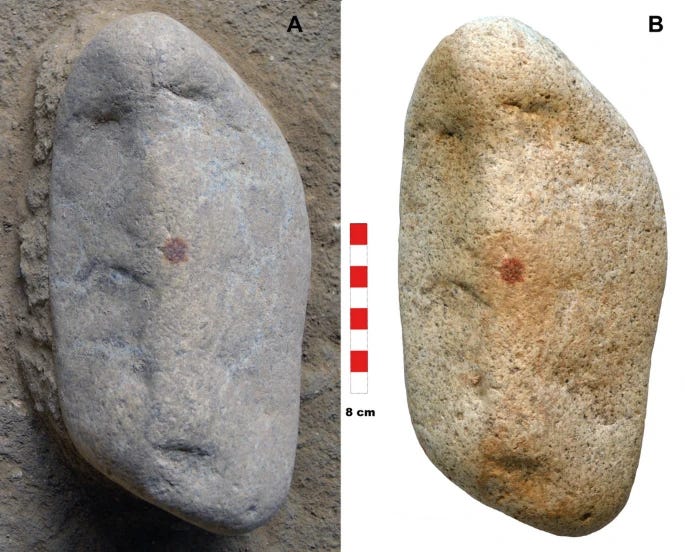🧐 Ancient Beat #153: Early seafaring, Neanderthal fingerprints, and the splitting of (interesting) hairs
Oh, hey there, stranger. Ancient Beat is back. Come and get it!
Annnd… we’re back!! Hi folks, thanks for bearing with me while I dealt with some personal stuff. I didn’t want to leave you too long without any of those sweet, sweet nuggets of ancient goodness, so I’m getting back to work.
FWIW, I actually wrote that I was taking a brief hiatus and that paid subscriptions were therefore paused… but now I see that I didn’t publish it. 😳 Sorry to leave you hanging and, again, thanks for bearing with me.
Okay, without further ado, here’s the latest ancient news. 👇
🗞 Ancient News: Top 5 (ehrm… Top 6)
Oldest Known Human Fingerprint Discovered On Ancient Neanderthal Artwork — At the Abrigo de San Lázaro site near Segovia, Spain, archaeologists uncovered a granite stone with a red ochre dot reinforcing the image of a human face — a clear instance of symbolic art dating back over 42,000 years. Embedded in the pigment is the oldest and most complete human fingerprint known, identified through multispectral forensic analysis as belonging to an adult Neanderthal male. The stone’s natural indentations resemble eyes and a mouth, with the added red pigment representing a nose — indicating deliberate artistic enhancement based on facial pareidolia. Scientific tests ruled out functional use of the object, confirming its symbolic purpose. The discovery adds to the growing evidence that Neanderthals engaged in abstract visual expression, challenging outdated notions that symbolic thought and art were exclusive to Homo sapiens. This fingerprint stands as a rare, direct trace of a Neanderthal’s cognitive and cultural world. What a cool, ultra-personal look into one individual 42,000 years ago.
New Evidence Reveals Advanced Maritime Technology In The Philippines 35,000 Years Ago — A genomic and archaeological study presents evidence that early humans reached the island of Mindoro approximately 35,000 years ago, crossing from mainland Southeast Asia across open ocean. This journey implies sophisticated maritime capabilities far earlier than previously believed. Genetic analysis reveals that these voyagers carried unique lineages, marking one of the longest prehistoric migrations, and left material traces indicating seafaring technology. Their navigation and boat‑building skills suggest intentional ocean voyages rather than accidental drift, significantly altering perspectives on Paleolithic migration and settlement patterns in the region. Since we’re already on the topic, here’s a bonus:
Archaeologists Discover Ancient Tools That Defy The Accepted Timeline Of Human Civilization — Stone tools recovered from sites in the Philippines, Indonesia, and Timor‑Leste date to as early as 40,000 years ago. These include sophisticated implements used for plant processing—likely for fibers to make ropes, nets, bindings—indicative of seafaring and open‑sea fishing. This challenges the view that early Paleolithic technological complexity was confined to Africa and Europe, pointing to advanced maritime skills in Southeast Asia far earlier than previously believed.
New Study Proposes How and Why Early Humans First Used Fire — Early humans, from roughly 1.8 million–800,000 years ago, tuned fire use not primarily for cooking but for preserving large-game meat by smoking and drying it—rendering meat less perishable and deterring predators. What’s that you say? The difference between “cooking” and “drying” is splitting hairs? How dare you?! Okay, yeah, we’re for sure splitting hairs here. But they’re interesting hairs. Anyway, evidence at multiple African, Middle Eastern, and Spanish sites supports this: burned bones but no signs of “cooking”, suggesting fire was a food-security tool rather than a culinary one at first. This purposeful use of fire for preservation challenges the long-held "cooking hypothesis" and reframes early fire mastery as motivated by long-term meat storage.
Archaeologists Find Intensive Indigenous Farming in Michigan — A laser-based survey along the Menominee River in Michigan’s Upper Peninsula uncovered an extensive network of raised garden beds dating from roughly the 10th century to 1600 CE. These earthen ridges—4 to 12 inches tall—covered over 300 acres and were used to grow corn, beans, squash, and other crops in spite of the region’s cold climate and short growing season. Radiocarbon dating confirms use between 1000 and 1600 CE. This may represent the most intact pre‑colonial agricultural field system in eastern North America.
Ancient DNA Reveals Prehistoric Matrilineal Society Shaped Neolithic China’s Burial Practices — Excavations at the Neolithic Fujia site on China’s Shandong coast, dating between 2750 and 2500 BCE, uncovered over 500 burials split between two cemeteries. Ancient DNA from 60 individuals revealed that each cemetery corresponded to a distinct maternal lineage — one group shared mitochondrial haplogroup M8a3, the other D5b1b — suggesting that burial was based on maternal descent. This points to a matrilineal social structure, contrasting with dominant patrilineal norms seen across much of Neolithic Eurasia. Both men and women were buried according to their maternal clan, not with spouses or paternal relatives. The community, associated with the Dawenkou culture, practiced a stable, sedentary lifestyle based on millet agriculture, pig domestication, and likely fishing. Radiocarbon dates suggest the cemetery was in continuous use for at least 250 years. Fujia joins a small group of global archaeological sites — like Chaco Canyon — with confirmed matrilineal organization based on genetic evidence.
That’s it for the free Top 5! If you’re a free subscriber, sign up for the paid plan for another 22 discoveries and 4 recommended pieces of content covering drinking contests, the Dead See Scrolls, the wheel, domestication, and more.
Until next time, thanks for joining me!
-James
Twitter: @jamesofthedrum
P.S. Here’s my Buy Me A Coffee link if you’d like to support my efforts with a donation.
P.P.S. If you want access to the paid version but it’s a little too steep for you right now, just email me — I want this to be accessible.
P.P.P.S. Paid members, read on!
🗞 Ancient News: Deep Dive
Keep reading with a 7-day free trial
Subscribe to Ancient Beat to keep reading this post and get 7 days of free access to the full post archives.


